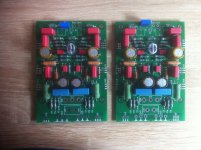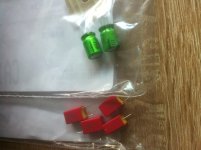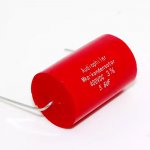@Paroxod4
But of course, you're right. The pcb is the real clone, measurements confirm that assumption. It sounds great. I have no doubts about that. I am still preparing an adequate chassis to move it from the garage into my house.
Someone suggests that we have physically identical board but esoteric components are missing. I'm not buying that fake news. I will use good components from reputable source and that's it: a good clone that sounds great and I like it.
But of course, you're right. The pcb is the real clone, measurements confirm that assumption. It sounds great. I have no doubts about that. I am still preparing an adequate chassis to move it from the garage into my house.
Someone suggests that we have physically identical board but esoteric components are missing. I'm not buying that fake news. I will use good components from reputable source and that's it: a good clone that sounds great and I like it.
I agree with it but not with some others.... That equipment is supposed to reproduce, not to compose....
Nowadays, every engineer is able to design amplifiers which have extreme low distortion. It is a basic task and not needed to use extraordinary solution like A-class, etc.
Obviously, dartzeel would be able to design similar way, but they wanted to create another thing. Presumably, they wanted to break into the tube amp segment of highend market and they wanted to provide a familiar sound effect to the unbelieving potential costumers and providing a new sound to others. Surprising price, surprising content, surprising marketing.
On the other hand, unfortunatelly, the extreme low distortion does not determine exactly what kind of impressions do you have during you listen to the certain amp.
Thanks shany,
Of course, taste and opinions may differ and everyone can get what he wants, if the budget allows.
However, to avoid endless of-topic conversation I'd like to ask you more practical question:
Could you please suggest which particular components should be selected to make our clones as close as possible to the original amplifier?
By values, producer and specific products.
I know, this is an easy question for you as I am aware of your expertise. 😎
Of course, taste and opinions may differ and everyone can get what he wants, if the budget allows.
However, to avoid endless of-topic conversation I'd like to ask you more practical question:
Could you please suggest which particular components should be selected to make our clones as close as possible to the original amplifier?
By values, producer and specific products.
I know, this is an easy question for you as I am aware of your expertise. 😎
4,7K/2W, 6,8K/2W - Vishay Sfernice RWM0410 ( or Vishay BCcomponents PR02 )...By values, producer and specific products....
39R/5W - Vishay Draloric AC05
other resistors - Vishay Beyschlag SMA 0207 ( Vishay Beyschlag MBB0207 )
47pF/100V, 150pF/100V - KEMET C052 ( or ?? )
1uF/63V - Wima MKS4C041003C
3,3uF - Wima MKS2C043301K00
22000uF/63V Vishay BCcomponents MAL210118223E3
330uF/35V - United Chemi-Con KMG - EKMG350EC3331MJC5S
0,68uF/100V - KEMET MMK - MMK15684K100B04L4 ?
22000uF/4.5V - AVX BestCap® - BZ054B223ZSBBQ
high current wiring: Kimber Kable TCX
sure it's a clone?Could you please suggest which particular components should be selected to make our clones as close as possible to the original amplifier?
do you want to do a cheap and very good sounding operation?
instead of 20,000 / 63 volt caps use caps, same manufacturer, but from 100 volts, even 10,000, the voltage and size of the case are important and you use a couple per channel, everything else is absolutely useless and wasteful
It is not necessary to fill the empty spaces with absurd caps and transformers to justify a price
Last edited:
Sure it's a clone?
A good question Domenico. I assume it is, at least from available answers and judging from my measurements.
As much I can recall UltimaLegione also indicated that we should select proper components to duplicate the original. Analog_SA has indicated also that proper components, including resistors, should be used to assure success. I have already placed an order to get good components, including these suggested by shany.
By the way, costs of the power supply along with chassis dictate the ovetrallcost, not the pcb and components. I have nothing against additional cost if that guarantee good quality. Let's just pay for quality improvements.
BTW, thanks shany, your input is valuable.
A good question Domenico. I assume it is, at least from available answers and judging from my measurements.
As much I can recall UltimaLegione also indicated that we should select proper components to duplicate the original. Analog_SA has indicated also that proper components, including resistors, should be used to assure success. I have already placed an order to get good components, including these suggested by shany.
By the way, costs of the power supply along with chassis dictate the ovetrallcost, not the pcb and components. I have nothing against additional cost if that guarantee good quality. Let's just pay for quality improvements.
BTW, thanks shany, your input is valuable.
I think it is wort to repost this post by analog_sa. It appears that proper selection of every component has impact on the quality of sound.UL, thanks for the detailed explanation of your mods.
There always seems to be a compromise between a single and multiple pairs in the outputs, depending on your speakers and taste.
My only suggestion would be towards better sounding resistors and possibly a lower value. Perhaps Caddock MP930, 0.25R.
Fortunately, I have a spare blank pcb to use for the final layout.
A good question Domenico. I assume it is, at least from available answers and judging from my measurements.
As much I can recall UltimaLegione also indicated that we should select proper components to duplicate the original. Analog_SA has indicated also that proper components, including resistors, should be used to assure success. I have already placed an order to get good components, including these suggested by shany.
By the way, costs of the power supply along with chassis dictate the ovetrallcost, not the pcb and components. I have nothing against additional cost if that guarantee good quality. Let's just pay for quality improvements.
BTW, thanks shany, your input is valuable.
then, I bought the pcb clone and it is indistinguishable from the original, resistors, BJT, cap.
I selected the 4 input bjts and all the rest, but those of the card were already matched: I did just slightly better
is a scheme whose sound depends a lot on the many caps present, 2 x 3.3 input, compensations and super caps.
Then the scheme is that, that is an open loop that would impose an exasperated selection of EVERYTHING, but I can select how much I want that the sound will derive almost entirely from the caps present.
if I change the input cap the sound varies a lot.
I, I insist, I would not make a power supply as in the original because it is of little or nothing, better a 300 VA transformer per channel with a pair of BC Vishay, but with voltages of 100 volts and NOT 63 volts, the capacity does not have importance.
If I change the 2 signal ground resistors in series, the supercap with Texas TX 2575 changes the sound again, for the better, but I would not spend for many Vishay caps
Hello everyone. I am slowly assembling an expensive (for me) version of Godzila, thanks to a friend from the USA, helped with the accessories. I am tormented with the choice of what to put on the input. On the one hand, there is Vima on the original, on the other hand there were opinions at the entrance, it is not very good (I did not notice it on the Chinese board), there is a non-polar nichikon for 10 microfarads. The question is what to put?
Attachments
I’d go for Audio Note KAISEI non-polar 5uf or 10uF/16V.
PS: I wonder why you put Takman resistors but left the WIMA caps in there 🙂
PS: I wonder why you put Takman resistors but left the WIMA caps in there 🙂
Last edited:
I'm glad to see you back. 🙂
I am sure analog_sa may provide the best advice on that.
I have WIMA MKS2 3,3uF 63V, but intend to replace it MKS2 4,7uF 63V with slightly larger WxLxH but it still fits on the board and has the same content spacing 5mm.
I am sure analog_sa may provide the best advice on that.
I have WIMA MKS2 3,3uF 63V, but intend to replace it MKS2 4,7uF 63V with slightly larger WxLxH but it still fits on the board and has the same content spacing 5mm.
Hello everyone. I am slowly assembling an expensive (for me) version of Godzila, thanks to a friend from the USA, helped with the accessories. I am tormented with the choice of what to put on the input. On the one hand, there is Vima on the original, on the other hand there were opinions at the entrance, it is not very good (I did not notice it on the Chinese board), there is a non-polar nichikon for 10 microfarads. The question is what to put?
Mundorf, aluminum oil series, costs the right amount and just accentuates the extreme high band, which is not harmful
EPSOS too, not bad and cheaper than mundorf, although Mundorf is better for this scheme
Last edited:
domenico80 Thank you, but I would like to be more specific about what is suitable for our boards, and where to buy. Brand, model and everything else. And so the name gives me nothing.😕🙂
There is an idea to put nichikon muse 10 microfarads and in parallel to it a good film camera 1 microfarad, but which one?😕
Read this carefully, written by Ian Finch.
And think
https://www.diyaudio.com/forums/solid-state/3075-jlh-10-watt-class-amplifier-350.html#post4940194
And think
https://www.diyaudio.com/forums/solid-state/3075-jlh-10-watt-class-amplifier-350.html#post4940194
Well, everything, struck on the spot, the result is nothing to change, as Dartzel planned, thanks.

- Home
- Amplifiers
- Solid State
- Dartzeel amp schematic - build this?


